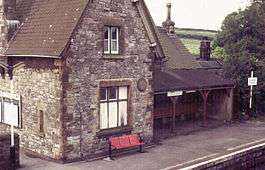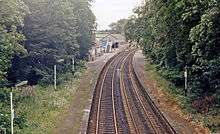Cark and Cartmel railway station
| Cark and Cartmel | |
|---|---|
 Main building at Cark & Cartmel station | |
| Location | |
| Place | Cark |
| Local authority | South Lakeland |
| Coordinates | 54°10′41″N 2°58′23″W / 54.178°N 2.973°WCoordinates: 54°10′41″N 2°58′23″W / 54.178°N 2.973°W |
| Grid reference | SD365762 |
| Operations | |
| Station code | CAK |
| Managed by | Northern |
| Number of platforms | 2 |
| DfT category | F2 |
|
Live arrivals/departures, station information and onward connections from National Rail Enquiries | |
| Annual rail passenger usage* | |
| 2012/13 |
|
| 2013/14 |
|
| 2014/15 |
|
| 2015/16 |
|
| 2016/17 |
|
| History | |
| Key dates | Opened 1857 |
| National Rail – UK railway stations | |
| * Annual estimated passenger usage based on sales of tickets in stated financial year(s) which end or originate at Cark and Cartmel from Office of Rail and Road statistics. Methodology may vary year on year. | |
|
| |

Cark and Cartmel railway station (often just Cark railway station) is a railway station that serves the villages of Cark, Flookburgh and Cartmel in Cumbria, England. It is located on the Furness Line from Barrow-in-Furness to Lancaster.
History
The station is architecturally interesting, with a main building (see image) erected by the Ulverstone and Lancaster Railway (U&LR) in 1857. The station opened on 1 September 1857 as Cark-in-Cartmell. The current name was adopted in 1906. The Furness Railway took over the U&LR on 21 January 1862 and was absorbed into the London Midland & Scottish Railway on 1 January 1923.
The station had a particular importance, as it serves Holker Hall, the home of Lord Cavendish of Furness formerly belonging to the Dukes of Devonshire. Special waiting rooms were provided for the dukes and their guests. The actual building retains many original features and is now a private residence. It extends to approximately one acre of gardens and woodland.
Facilities
The station is unstaffed and has no ticket facilities of any kind (tickets must be purchased on the train or in advance). There are shelters and digital information screens on each platform, along with a long-line P.A system for train running information provision. The platforms are linked by a footbridge, but step-free access is also available on each side for disabled travellers.[1]
Service
The station is on the Furness line linking Lancaster and Barrow (though some services extend south to Preston or north east to Carlisle).
- The station receives a roughly hourly service to Barrow operated by Northern and calling at:
- Four of these services continue from Barrow on to Carlisle calling at:
- Askam, Kirkby-in-Furness, Foxfield, Green Road, Millom, Silecroft, Bootle, Ravenglass, Drigg, Seascale, Sellafield, Braystones, Nethertown, St Bees, Corkickle, Whitehaven, Parton, Harrington, Workington, Flimby, Maryport, Aspatria, Wigton, Dalston and Carlisle. Two evening trains terminate at Millom and one afternoon train at Sellafield (weekdays only).
- There is also a roughly hourly service towards Lancaster, calling at:
- Kents Bank, Grange over Sands, Arnside, Silverdale, Carnforth and Lancaster. Three services a day are extended to Preston, calling additionally at Preston only
A limited number of services continue through to Manchester Airport via Bolton and Manchester Piccadilly - these were formerly operated by First TransPennine Express up until the end of the old Northern and TransPennine franchises on 31 March 2016.
Sundays see an hourly service each way (with some longer gaps).[2]
References
- ↑ Cark and Cartmel Station Information National Rail Enquiries; Retrieved 25 November 2016
- ↑ Table 82 National Rail timetable, May 2018
External links
| Wikimedia Commons has media related to Cark and Cartmel railway station. |
- Train times and station information for Cark and Cartmel railway station from National Rail
| Preceding station | Following station | |||
|---|---|---|---|---|
| Northern Furness Line |